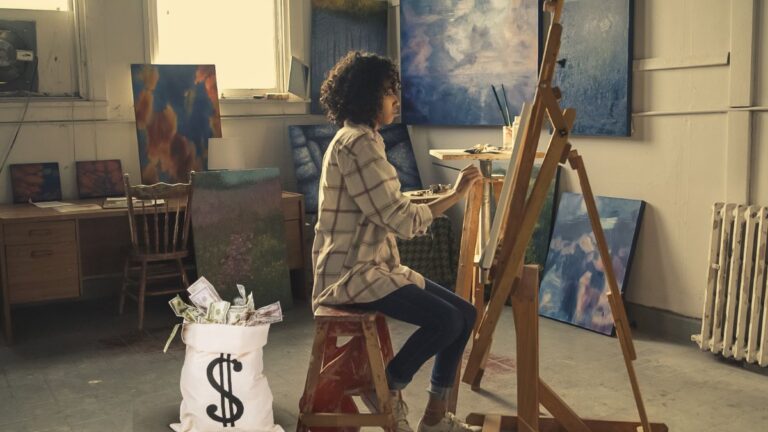Make Money as an Artist: Being an artist is about more than simply producing stunning works of art; it’s also about figuring out how to make a living doing what you love while being true to who you are. In the year 2023, there are a plethora of avenues open to creatives for monetizing their skills and making a career doing what they are most passionate about. In this blog article, we’ll examine 10 unique methods for artists to generate money in the ever-evolving art market.
1. Advertise and Sell Your Artwork Online
The distribution of creative works has been profoundly altered by the advent of the internet. You may market your artwork by establishing an online portfolio and selling it on numerous websites, such as Etsy, eBay, or even your own website. This opens the door for you to communicate with art lovers and collectors from all around the world.
Advice: If you want to properly promote your artwork, you should invest in quality photographs and include extensive descriptions as well as information on price.
2. Services of Printing Documents Upon Request
Print-on-demand services, such as Society6, Redbubble, and Printful, enable artists to submit their ideas. This can then be printed on a variety of things, such as clothes, home décor, and accessories. Print-on-demand services are becoming more popular. Every time a sale is made, you get a commission, and the platform is responsible for manufacturing and shipment.
Advice: Try out a variety of product categories to discover which ones are most well received by your target market. Then advertise your wares through online platforms such as social media and email marketing.
3. Patronage of the Arts
It is a customized approach to engage with customers and produce one-of-a-kind works of art. They can be suited to the tastes of the individual customer when you provide bespoke art commissions. You may accept commissions from people and companies to create portraits, pet portraits, or other types of commissioned artwork.
Advice: Make sure to clarify your method for taking commissions. Include the prices you charge, the timeframes you adhere to, and the degree of personalization you provide.
4. Art Rights and Licenses
Giving permission to a company to use your artwork on their products is an essential part of the art licensing process. This is regardless of whether they are physical (such as stationery or clothing) or digital (such as websites or apps)The acquisition of licenses may result in a reliable flow of passive revenue.
Advice: If you want to interact with possible licensing partners, look for licensing agencies. Or you go to trade exhibitions that are relevant to your industry.
5. Workshops & Classes in the Arts
Art workshops and courses are a satisfying opportunity to educate others. But it is also a source of revenue for those who choose to share their knowledge and abilities with others. You may teach individuals in-person, do webinars, or develop and deliver online courses.
Advice: To promote your courses and position yourself as an authority in your field, market them on online education marketplaces. Such as Skillshare, Udemy, or Teachable.
6. Peer-to-peer finance and patronage systems
Platforms such as Patreon make it possible for artists to collect regular payments from fans. They support they have garnered because of their work. In exchange for their support, supporters often get customized artwork, behind-the-scenes access, or access to special material.
Advice: Provide your customers with appealing benefits, such as advanced access to newly created artwork or prints that are limited in edition.
7. Grants and Residency Programs for Artists
Grants and residencies in the arts may provide not just financial assistance but also opportunity to create new work. Numerous organizations provide financial assistance in the form of grants, scholarships, and residencies to artists so that they may produce new work or investigate certain ideas.
Advice: Do some research and submit applications for scholarships and residencies that are relevant to your region or creative discipline.
8. Art Shows and Merchandise Markets
Gaining visibility for your work and selling it directly to buyers is both possible and beneficial when you take part in art fairs and exhibits. If you want to show off your artwork, you can look into participating in local art fairs, gallery exhibits, and events that are judged.
During these events, you should develop a professional portfolio, and you should also network with other artists and art aficionados.
9. Independent Creative Work in Illustration and Design
Freelancing is an option Make Money as an Artist who possesses great illustration or graphic design abilities and who want to sell their services to clients. Creating things like book covers, editorial drawings, branding materials, and other similar things might fall under this category.
Constructing a robust online portfolio is the best way to demonstrate your adaptability to prospective customers and garner their interest.
10. non-fungible tokens (NFTs) for works of art
The proliferation of blockchain technology has made new options available to Make Money as an Artist, including the production and selling of non-fungible tokens (NFTs). The ownership of digital or physical assets, like as artwork, is represented by non-fungible tokens (NFTs). Minting works of art as non-fungible tokens (NFTs) and selling them on NFT marketplaces such as OpenSea or Rarible is an option for artists.
Advice: Get informed on non-fungible tokens (NFTs), think about their influence on the environment, and choose trustworthy NFT platforms.
Make Money as an Artist: The final word
The field of art is always developing, and contemporary artists have more chances than they ever have had before to earn a living off of their creative abilities. There are a lot of different ways to make money off of your art in the year 2023; whether you decide to sell your artwork online, investigate print-on-demand services, give commissions, conduct workshops, or embrace rising trends like NFTs, you have a lot of options.
Keep in mind that it may take some time and consistent effort for you to build up a sustainable income as an artist. It is very necessary to consistently advertise your work, interact with your audience, and adapt to the ever-shifting dynamics of the market. You may transform your creativity into a successful job if you combine your creative enthusiasm with smart commercial endeavors. This will allow you to capitalize on your unique abilities.





